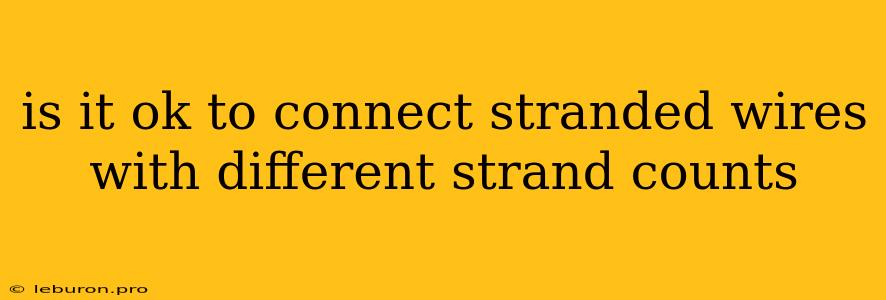Connecting wires with different strand counts is a common question that arises in electrical work. While it may seem like a simple task, there are several factors to consider to ensure a safe and reliable connection. This article will delve into the considerations and best practices for connecting stranded wires with different strand counts, addressing the potential risks and providing practical solutions.
Understanding Stranded Wires and Strand Count
Stranded wires are composed of multiple thin wires twisted together, offering flexibility and reduced resistance compared to solid wires. The strand count refers to the number of individual wires within a larger conductor. A higher strand count usually indicates greater flexibility and lower resistance.
Why Strand Count Matters
The strand count plays a significant role in determining a wire's flexibility, current carrying capacity, and ability to withstand mechanical stress. Wires with a higher strand count are generally more flexible and can handle tighter bends without breaking. They also have a lower resistance due to the larger surface area for current flow, making them suitable for high-current applications.
Connecting Stranded Wires: The Challenges
Connecting stranded wires with different strand counts presents a few challenges:
1. Mismatched Flexibility: Wires with significantly different strand counts may have varying degrees of flexibility. Connecting a highly flexible wire to a less flexible one can result in uneven stress distribution, potentially leading to wire fatigue and premature failure.
2. Potential for Loose Connections: When connecting wires with different strand counts, the smaller strands in the thinner wire may not fully make contact with the larger strands in the thicker wire, resulting in a less secure connection and increased resistance.
3. Uneven Current Distribution: The larger wire with a higher strand count may carry a disproportionately larger share of the current, leading to localized overheating and potential fire hazards.
Best Practices for Connecting Stranded Wires with Different Strand Counts
To ensure a safe and reliable connection, consider the following best practices:
1. Use Crimp Connectors:
Crimp connectors, specifically designed for stranded wires, provide a secure and reliable connection by compressing the wires together under high pressure. Ensure that the connector is rated for the appropriate wire size and current capacity.
2. Utilize Wire Nuts:
For smaller gauge wires, wire nuts can be an effective solution. Select a wire nut that is rated for the appropriate wire size and number of wires being connected. Make sure to twist the wire nut tightly to ensure a secure connection.
3. Employ Terminal Blocks:
Terminal blocks provide a convenient and organized way to connect multiple wires, including those with different strand counts. Choose a terminal block that is rated for the appropriate current and voltage.
4. Consider Wire Stripping:
Stripping the wire insulation to a consistent length for both wires helps ensure a good contact between strands. Ensure the stripped length is adequate for the chosen connector or method.
5. Use Solder:
Soldering can create a stronger and more reliable connection, especially when dealing with wires with significantly different strand counts. However, ensure the solder is compatible with the wire material and that the connection is properly insulated after soldering.
6. Avoid Twisting Wires Directly:
Twisting wires directly together without a connector is generally not recommended as it can create an unreliable connection and a potential fire hazard.
Choosing the Right Connection Method
The best method for connecting stranded wires with different strand counts depends on several factors, including:
- Wire Gauge: The size of the wires will determine the appropriate connector or technique.
- Application: The intended use of the connection will influence the level of reliability and safety required.
- Environmental Conditions: The operating environment, such as temperature or moisture, can affect the chosen method.
Precautions and Safety Tips
Connecting stranded wires with different strand counts requires careful consideration and proper techniques to ensure safety and reliability. Here are some essential precautions:
- Always use appropriate connectors or techniques: Ensure that the chosen connection method is rated for the wire sizes and current capacity.
- Inspect connections regularly: Periodically inspect the connections for signs of overheating, loose connections, or damage.
- Follow electrical codes: Always adhere to local and national electrical codes to ensure safe and compliant installations.
Conclusion
Connecting stranded wires with different strand counts requires understanding the potential challenges and implementing appropriate techniques. By following best practices, using suitable connectors, and taking necessary precautions, you can create reliable and safe connections that meet the requirements of your electrical projects. Remember to always prioritize safety and consult with a qualified electrician if you have any doubts or concerns about connecting stranded wires.
